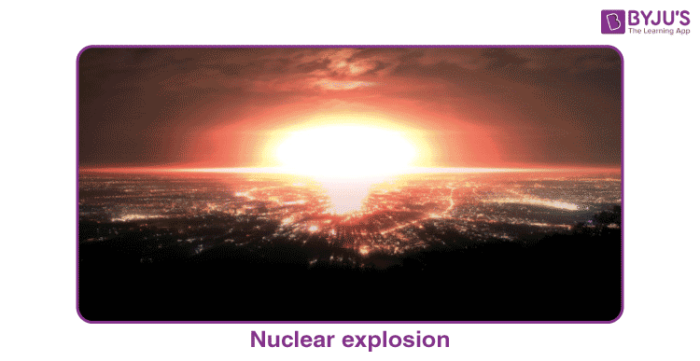Nuclear reactions are fundamental processes that govern the interactions of atomic nuclei, yielding a diverse array of applications in both theoretical and practical realms of physics. Central to these reactions are the projectiles – particles that initiate the nuclear interactions. Understanding the nature and behavior of these projectiles is imperative for grasping the intricacies of nuclear chemistry, astrophysics, and energy production. This article elucidates the concept of projectiles in nuclear reactions, encompassing their types, roles, and significance in contemporary scientific inquiry.
1. Definition of Projectiles in Nuclear Reactions
In the vernacular of nuclear physics, a projectile is defined as a particle that collides with a target nucleus, instigating a nuclear reaction. This interaction can result in a plethora of outcomes, including Rutherford scattering, nuclear fission, nuclear fusion, or the emission of secondary particles. The characteristics of the projectile – such as its mass, charge, and energy – predominantly influence the nature of the ensuing reaction.
2. Types of Projectiles in Nuclear Reactions
There exists a multifarious array of particles that can function as projectiles in nuclear reactions, each classified based on their intrinsic properties:
- Alpha Particles (α): Comprising two protons and two neutrons, alpha particles are positively charged and relatively heavy. Their substantial mass imparts them a lower velocity relative to lighter particles, yet their formidable energy allows them to induce significant nuclear changes, particularly in heavy nuclei through mechanisms such as alpha decay.
- Beta Particles (β): These are high-energy, high-speed electrons (or positrons) emitted by certain types of radioactive decay. Beta particles possess negligible mass and a negative charge (in the case of electrons) and can penetrate various materials, facilitating interactions with target nuclei that may otherwise be untouched by the heavier projectiles.
- Neutrons: Neutron projectiles, possessing no electric charge, play a crucial role in many nuclear reactions, particularly in fission processes. Their lack of charge allows them to penetrate the nuclear barrier of a target nucleus with greater ease, thereby promoting interactions that can lead to chain reactions in nuclear reactors.
- Protons: As positively charged particles, protons are often employed in particle accelerators and collide with target nuclei to induce reactions such as spallation or the creation of new isotopes. Their charge, in contrast to neutrons, influences their trajectory and interaction cross-sections significantly.
- Heavy Ions: These are composite nuclei, such as those of lead or gold, which possess a larger number of protons and neutrons. When accelerated, heavy ions can impart substantial energy to target nuclei, leading to the synthesis of superheavy elements or the study of nuclear structure under extreme conditions.
3. The Role of Projectiles in Nuclear Reactions
The function of projectiles is far-reaching and multifaceted, contributing to various scientific domains:
- Energy Production: In nuclear reactors, neutrons serve as projectiles to sustain chain reactions. Their ability to initiate fission in uranium or plutonium nuclei is paramount for the generation of energy. This reaction releases vast amounts of energy, a principle that has been harnessed for electricity generation globally.
- Medical Applications: Radioisotope production for medical diagnostics and treatment relies heavily on nuclear reactions initiated by projectiles. These reactions enable the generation of isotopes utilized in PET scans or cancer therapy, showcasing the practical implications of projectiles in medicine.
- Nuclear Research: Projectiles are instrumental in experimental nuclear physics, where they facilitate the exploration of nuclear structures and reaction mechanisms. By colliding projectiles with various nuclei, researchers can map the nuclear landscape, providing insights into fundamental forces and the behavior of matter at the subatomic level.
- Astrophysics: In astrophysical contexts, particles such as protons and alpha particles act as projectiles in stellar nucleosynthesis. These reactions are foundational for the formation of heavier elements in stars, influencing the elemental abundance observed throughout the universe.
4. Projectiles and Nuclear Safety
The management of projectiles, particularly in nuclear reactors and research facilities, necessitates stringent safety protocols. Understanding how potential projectiles interact with materials extends to radiation shielding, which is critical for safeguarding personnel and the environment. Innovations in materials science can enhance protective barriers, thus mitigating risk during high-energy collisions.
5. Conclusion
Projectiles in nuclear reactions represent a cornerstone of nuclear physics, defining the interactions that underpin both natural phenomena and engineered applications. Their diverse forms – ranging from alpha particles to heavy ions – facilitate an expansive array of scientific inquiries and practical solutions, emphasizing the essential nature of these particles in understanding the complexities of atomic behavior. As research progresses, the continued exploration of projectiles and their reactions promises to unveil further intricacies of the atomic world, solidifying their role in the ongoing narrative of scientific discovery.












